On the previous page, it was shown that the official Atlantic Hurricane season lasts from June first through the end of November, and that on average, there are 10.6 tropical storms, 5.9 hurricanes, and 2.0 major hurricanes (category 3 and higher). Figure 8 shows that Atlantic hurricane activity peaks in early September and that storms occasionally form outside the official hurricane season in May and December.
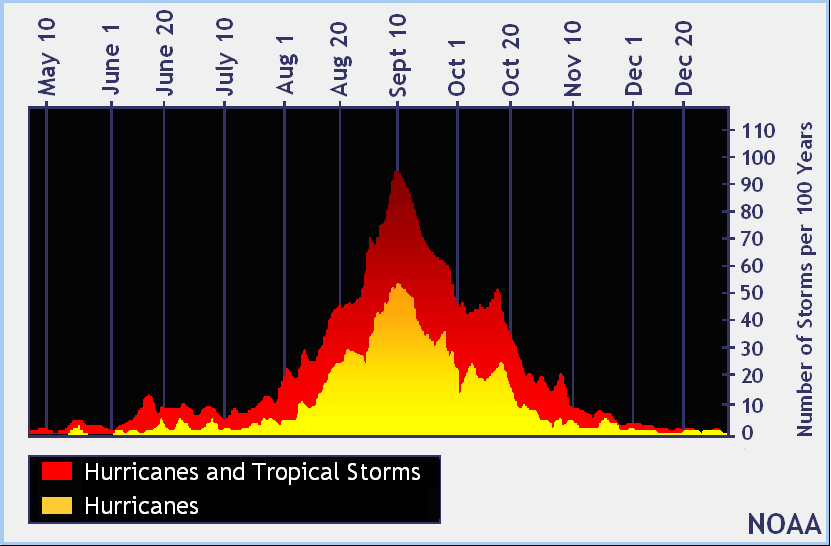 |
| Figure 8: Average number of Atlantic Hurricanes per century as a function of calendar date. |
In addition, there is quite a bit of variation in the number of Atlantic hurricanes from year to year as shown in figure 9.
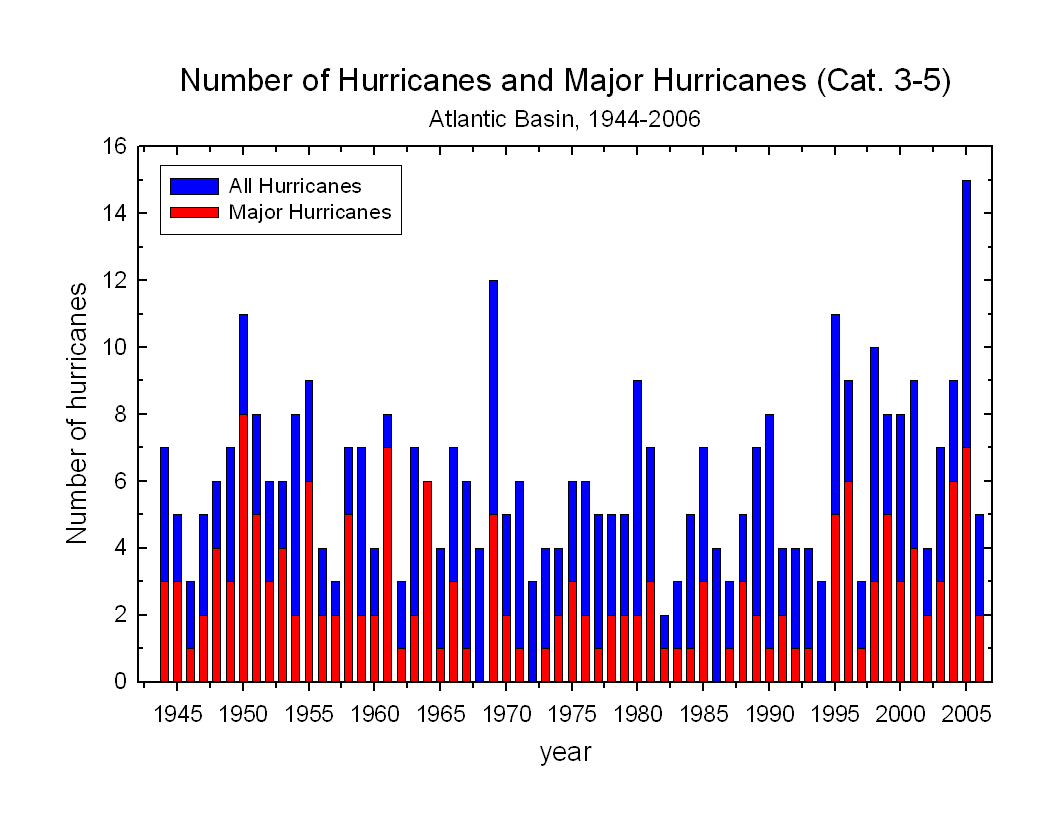 |
| Figure 9: The number of tropical storms in the Atlantic basin each year from 1944 to 2004. Red indicates the number of major hurricanes (category 3 and higher), while blue indicates tropical storms and category 1 and 2 hurricanes. |
An obvious question comes to mind: "Is there a significant temporal pattern in the number of Atlantic hurricanes?" Many researchers have concluded that there is a multi-decadal cycle, consisting of 20 - 30 year periods of increased hurricane activity followed by 20 - 30 year periods of decreased hurricane activity. Dr. Gray from Colorado State University, famous for his seasonal hurricane forecasts, put together the following figure, re-labelled with my caption as Figure 10. The figure shows that hurricane activity in the Atlantic was high from the late 1940s through the mid 1960s, followed by a period of low activity from the mid 1960s to the mid 1990s. Since 1995 we have been in another highly active period, which will likely continue for about another decade into the future.
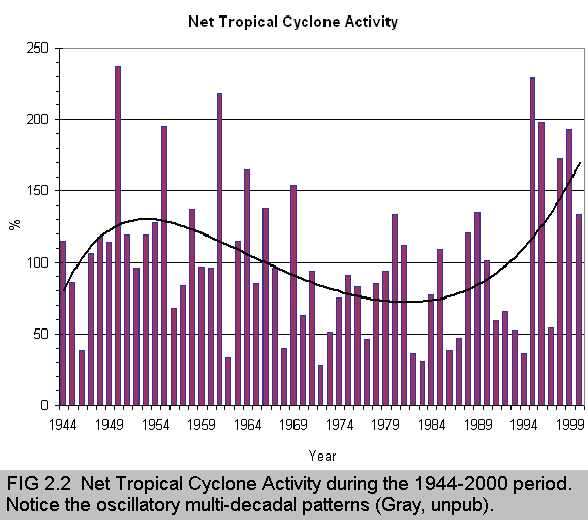 |
| Figure 10: In his research, Dr. Gray defined a unit called net tropical cyclone activity which measures number of storms and storm intensity in the Atlantic. 100% is the long-term average and there remains much variation from year to year. However, the solid line on the graph shows a smoothed running mean of net tropical cyclone activity, which indicates the multi-decadal trend. |
There is much more evidence to support the claim of a multi-decadal scale in Atlantic hurricane activity. For example paleoclimate studies that search for evidence of past hurricane damage see indications of oscillating periods of hurricane activity with decadal timescales. Most researchers believe that these trends occur. The reason for the trend seems to be related to natural fluctuations in the Atlantic sea surface temperature and wind patterns. During active periods, sea surface temperatures are high and wind patterns favor storm development. Based on this information, we should expect hurricane activity in the Atlantic basin to remain high for at least the next 10 years.
While variations in the total number of hurricanes in the Atlantic Ocean is interesting, keep in mind that most people only remember the ones that cause death and destruction on the coast. Many Atlantic hurricanes stay out at sea or are relatively weak when they make landfall. Those few hurricanes that reach category 4 and 5, only remain at that strength for short periods of time, which on average is less than 24 hours. The chance that one of these monsters will hit the U.S. mainland as a category 4 or 5 storm is relatively low (see table 4 below). Note that from 1851-2004 there were only 3 category 5 and only 15 category 4 hurricanes at the time of landfall with the continental United States. During the 2005 hurricane season, Katrina hit as a category 4 storm and Dennis, Rita, and Wilma hit land as a category 3 storms. The fact that major hurricanes hit the mainland U.S. so infrequently contributes to public unawareness of their potential devastion (see last section below). In particular very few powerful hurricanes struck the U.S. mainland from 1970 - 1990; People from that era became desensitized to the potential devastion of hurricanes and developed a false sense of security.
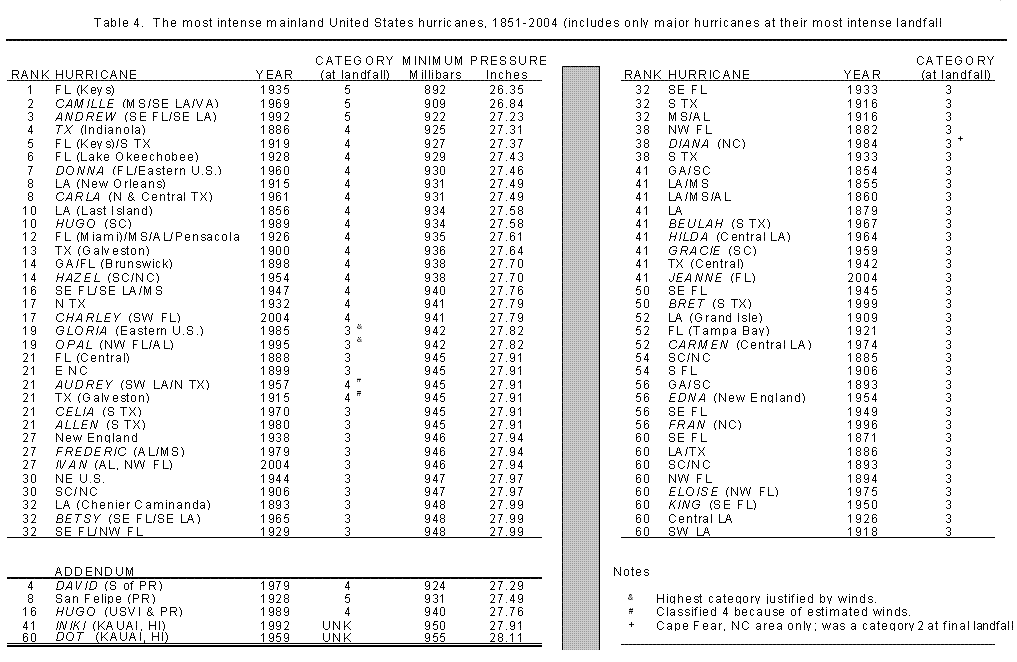 |
Map indicating the location and strength of all major landfalling hurricanes (category 3 and higher) in the United States from 1899 through 2005. The overall average is slightly less than one per year. 2005 had a record of four major landfalling hurricanes: Dennis, Katrina, Rita, and Wilma.
Public attention for hurricanes is primarily driven by lanfalling hurricanes that result in death and destruction, rather than fluctuations in the number of hurricanes in the Atlantic. In 2004, four hurricanes (three major hurricanes) hit the state of Florida, followed in 2005 by Katrina, the most costly natural disaster in United States history, as well as three other major landfalling hurricanes, Dennis, Rita, and Wilma. In fact, the 2005 Atlantic hurricane season was record-breaking. The 27 named tropical storms broke the old record of 21; 15 of these tropical storms became hurricanes, breaking the old record of 12; 4 hurricanes made landfall over the United States at category 3 or higher breaking the old record of 3 set in 2004. A good summary of the record breaking hurricane season of 2005 is given in the article: 2005: A Hurricane season 'On Edge'. The result is that hurricanes are under public scrutiny. And anytime a weather disaster happens today, you can be sure that someone will try to link it to global warming.
The basis for a link to global warming is as follows ... As humans add greenhouse gases to the atmosphere, the average surface temperature of the Earth should increase. One consequence is that global sea surface temperatures will increase. Measurements do show that the global average sea surface temperature has been increasing in recent years ... Therefore, since hurricanes feed off warm ocean water, the recent strong landfalling hurricanes in the United States directly results from global warming.
While the above argument seems plausible, it cannot be scientifically proven at this time. As mentioned above, the recent increase in Atlantic hurricanes can be better explained as a continuation of the multi-decadal cycle discussed above. The 2004 and 2005 hurricane seasons are not overly abnormal when viewed in the context of hurricane cycles over the last 100 years and beyond. The multi-decadal cycle itself certainly cannot be attributed to global warming. Furthermore, hurricane development requires more than just warm sea surface temperatures -- how are these other development factors influenced by global warming? While we cannot say with certainty that global warming has had no influence on hurricane development, based on the best available scientific evidence, it is wrong to say that global warming has been directly responsible for the 2004 and 2005 hurricanes (also see statement from Dr. William Gray at the end of this section). I believe it is dangerous to explain Katrina (or even the record-breaking 2005 hurricane season) through global warming because we have always had strong hurricanes in the USA - the strongest one on record dates back to 1935.
On the other side of the issue, a recent study by Kerry Emanuel, a leading U.S. hurricane researcher, has concluded that while the number of hurricanes have not changed, the windspeeds (a measure of storm intensity) have increased in recent years. However, it has not been scientifically proven that the increased hurricane windspeed is defintely due to global warming. One problem with that study is that we can only look back about 35 years with satellite data; before that the hurricane record is somewhat unreliable, and 35 years isn't long enough to draw a definite conclusion. We certainly can't rule out the possibility that this is part of a natural cycle in hurricane activity. Before global satellite coverage, there are gaps in the historical hurricane record; thus, prior to 35 years ago, even strong storms that spent their entire lifecycle out at sea, were probably unnoticed. We are going to need many more years of good hurricane observations before we will be able to conclude without doubt that global warming is having a large impact on the intensity of hurricanes ... to be able to rule out the possibility that observed fluctuations in hurricane intensity are not part of a natural climatic cycle.
In spite of the lack of scientific proof, many in the media flock to those who make assertations about influence of global warming on United States hurricanes. See Germany's Environment Minister, Juergen Trittin, cites greenhouse gas emissions as cause for Katrina. In my opinion, the German minister (among others) is using the Katrina disaster to further his agenda to reduce emissions of greenhouse gases for fear of global climate change. While this is a noble agenda, he should base his arguments on sound scientific evidence, not scare tactics.
The following statement was taken from FORECAST OF ATLANTIC HURRICANE ACTIVITY FOR SEPTEMBER AND OCTOBER 2005 AND SEASONAL UPDATE THROUGH AUGUST by William Gray and Philip Klotzbach:
"Many individuals have queried whether the unprecedented landfall of four destructive hurricanes in a seven-week period during August-September 2004 and the landfall of two more major hurricanes in the early part of the 2005 season is related in any way to human-induced climate changes. There is no evidence that this is the case. If global warming were the cause of the increase in United States hurricane landfalls in 2004 and 2005 and the overall increase in Atlantic basin major hurricane activity of the past eleven years (1995-2005), one would expect to see an increase in tropical cyclone activity in the other storm basins as well (ie., West Pacific, East Pacific, Indian Ocean, etc.). This has not occurred. When tropical cyclones worldwide are summed, there has actually been a slight decrease since 1995. In addition, it has been well-documented that the measured global warming during the 25-year period of 1970-1994 was accompanied by a downturn in Atlantic basin major hurricane activity over what was experienced during the 1930s through the 1960s.
We attribute the heightened Atlantic major hurricane activity between 1995-2005 to be a consequence of the multidecadal fluctuations in the Atlantic Ocean thermohaline circulation (THC) as we have been discussing in our Atlantic basin seasonal hurricane forecasts for several years. Major hurricane activity in the Atlantic has been shown to undergo marked multidecadal fluctuations that are directly related to North Atlantic sea surface temperature anomalies. When the Atlantic Ocean thermohaline circulation is running strong, the central Atlantic equatorial trough (ITCZ) becomes stronger. The stronger the Atlantic equatorial trough becomes, the more favorable are conditions for the development of major hurricanes in the central Atlantic. Since 1995, the THC has been flowing more strongly, and there has been a concomitant increase in major hurricanes in the tropical Atlantic.
There have been similar past periods (1940s-1950s) when the Atlantic was just as active as in recent years. For instance, when we compare Atlantic basin hurricane numbers of the last 15 years with an earlier 15-year period (1950-64), we see no difference in hurricane frequency or intensity even though the global surface temperatures were cooler and there was a general global cooling during 1950-64 as compared with global warming during 1990-2004."
Arguments for a link between global warming and increased hurricane intensity are summarized in this short video segment produced by PBS: Is global warming making hurricanes more intense?
Prior to hurricane Katrina, I would show a figure, like figure 11, which shows that the dollar cost in damage due to hurricanes is increasing, while actual loss of life has been quite low.
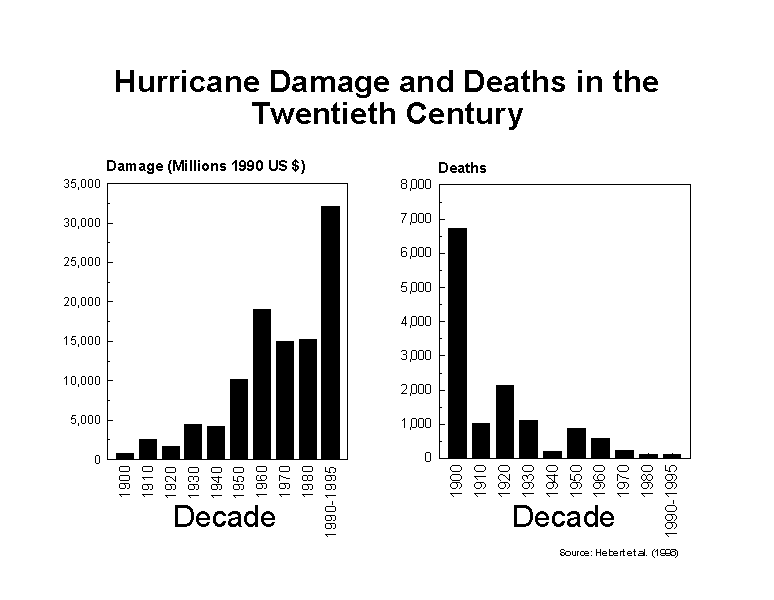 |
| Figure 11: Hurricane damage and death each decade from 1900-1995. Dollar damage estimates have been normalized for inflation. |
The increadible rise in the value of houses over the past few years has driven further the likelihood of billion dollar distasters upward.
Katrina forces us to reconsider the long-held belief that hurricanes will not cause many deaths in the United States because we have such a great hurricane monitoring system and no storm will catch anyone by surprise. Sure property damage was high (Katrina will surpass Andrew as the most expensive hurricane ever), but we have come to expect that. The question here is Even with the ample warning provided by the National Hurricane Center, why did so many people die as a result of Katrina? Last count is over 1300 confirmed deaths. This is the most deaths related to a single hurricane since 1928. There are many reasons for the large loss of life. Undoubtedly the vulnerability of the New Orleans area to levee failure and flooding was a strong contributing factor and had Katrina hit somewhere else there would have been less loss of life.
Much of the next three paragraphs are opinions. You need to think these issues over and formulate your own opinions.
A question to consider: "Why did so many residents remain even though they were warned to leave?" Federal, state and local governments responded poorly to the disaster, but the only sure way to save lives is for people to evacuate before the storm hits. A poor reason heard over and over from survivors is that they did not leave because they didn't think things could get that bad. This reaction is probably due to the several factors: (1) major hurricanes don't strike very often; (2) many residents were either new to the gulf coast or never experienced a major hurricane before; (3) some had stayed and lived through other hurricanes, thinking that they are no big deal; and (4) some had evacuated for previous storms that may have missed their house or turned out to be not that severe, so they refused to leave this time. Individuals must educate themselves and make responsible decisions for themselves, their families, and anyone else who relies on them. People living in hurricane prone areas need to understand the devastion that hurricanes can cause, keep informed on hurricane activity in their area, and be prepared to make intelligent decisions. People in New Orleans had the additional responsibility to understand the vulnerability of their city to the possibility of levee breaks whenever a major storm is near.
Another issue is whether or not we as a society should continue to build-in and populate hurricane prone areas. Given that people desire to live right on warm water coasts and the very high short-term value available to investors and politicians, it would seem very unlikely to me that we as a society will not continue to build new and more lavishly on coastlines that are vulnerable to hurricanes. Another possibility is to regulate through building codes that all structures be able to withstand the worst possible hurricane, but this is quite costly as well and may not even be successful as the floating gambling casinos in Mississippi proved. We will probably have to accept that hurricanes will cause major property damage from time to time. A "market correction" is underway as insurance costs in Florida have tripled over the past few years because of the 2004 and 2005 hurricane seasons. This has caused people to leave Florida and presumably will drive some housing prices down as they become uninsurable. The benign 2006 season combined with higher insurance premiums caused 2006 to be a year of record profits for insurance companies. January 2007 NY Times article about insurance in Florida
The need for large scale evacuations for urban areas on coastlines must be developed by urban planners. Evacuations from New Orleans and Houston in 2005 were very slow and led to some deaths while leaving many people, particularly the poor, still in place in New Orleans
Should hurricane damaged areas be rebuilt? Who should pay for the rebuilding? Current practice is for the federal government to reimburse people for their losses due to natural disasters. Thus most rebuild in the same disaster-prone area. In a sense the federal government encourages people to rebuild at a large cost to taxpayers. People who build in these areas have to assume the risks involved, that is, find private insurance or risk large scale loss. Note also that the state governments such as Florida are getting into the act to deal with rising insurance costs (see the NY Times article above). Florida is trying to work a compromise with the state taking on some of the insurance risk to keep people in Florida and make them happier and to absorb some of the high insurance risks.
A Katrina-type disaster was foreseen by many people. In fact a New Orleans newspaper published an article in 2001 about a devasting senario very close to what actually happened. A simulated hurricane disaster was performed in 2004 in New Orleans involving federal, state and local governments that predicted results actually worse than Katrina. Unfortunately, nothing seems to have come from that exercise in terms of government preparedness. In fact, in retrospect, it seems unclear why the exercise was undertaken given how little it changed preparedness seemingly at any level. The danger remains and with global warming may in fact be increasing, particularly in terms of extreme events. This is one of several key areas where global warming can have real socio-economic impact on the US. Quoting the sumarizing statement from a report generated by the National Hurricane Center (which was prepared prior to the 2004 and 2005 monster hurricane seasons):
"In virtually every coastal city of any size from Texas to Maine, the present National Hurricane Center Director, Max Mayfield, has stated that the United States is building toward its next hurricane disaster. The population growth and low hurricane experience levels of many of the current residents, form the basis for this statement. The areas along the United States Gulf and Atlantic coasts where most of this country's hurricane related fatalities have occurred are also now experiencing the country's most significant growth in population. This situation, in combination with continued building along the coast, will lead to serious problems for many areas in hurricanes. Because it is likely that people will always be attracted to live along the shoreline, a solution to the problem lies in education, preparedness and mitigation.
The message to coastal residents is: Become familiar with what hurricanes can do, and when a hurricane threatens your area, increase your chances of survival by moving away from the water until the hurricane has passed! Unless this message is clearly understood by coastal residents through a thorough and continuing preparedness effort, disastrous loss of life is inevitable in the future."